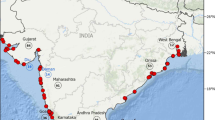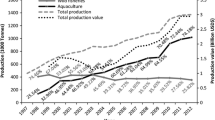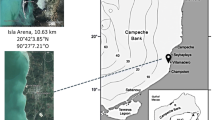Abstract
Many vulnerable marine species are caught in small-scale fisheries that lack long-term records, thereby limiting the development of effective evidence-based management measures. To uncover recent trends in fish landings and value in the absence of historical data, we interviewed 77 fishers and five buyers on Phu Quoc Island in Southern Vietnam regarding their current and past fishing practices, with a focus on seahorse catches. Seahorses (Hippocampus spp.) are caught using multiple gear types (including trawls, crab nets, and compressor diving) and have both cultural and financial value. Most fishers catch seahorses incidentally, though 14 targeted them and made the majority of their income from their sale. Fishers reported that seahorse catch rates decreased by 86–95% from 2004 to 2014, while landed value simultaneously increased by 534%. If these reports are accurate, seahorse fishing on Phu Quoc is unsustainable and requires immediate management controls.





Similar content being viewed by others
References
Alfaro-Shigueto, J., Mangel, J. C. J., Pajuelo, M., Dutton, P. H., Seminoff, J. a., and Godley, B. J. (2010). Where small can have a large impact: Structure and characterization of small-scale fisheries in Peru. Fisheries Research 106: 8–17. https://doi.org/10.1016/j.fishres.2010.06.004.
Aylesworth, L., Phoonsawat, R., Vincent, A.C.J. (2017). Effects of indiscriminate fisheries on a group of small data-poor species in Thailand. ICES Journal Marine Science.
Béné, C., Macfadyen, G., Allison, E. (2007). Increasing the contribution of small-scale fisheries to poverty alleviation and food security. Food and Agriculture Organization United Nations No. 481.
Berkes, F. (2003). Alternatives to conventional management: Lessons from small-scale fisheries. Environments 31: 5–20.
Berkes, F., Colding, J., and Folke, C. (2000). Rediscovery of traditional ecological knowledge as adaptive management. Ecological Applications 10: 1251–1262.
Berkes, F., Mahon, R., McConney, P., Pollnac, R., and Pomeroy, R. (2001). Managing small-scale fisheries: Alternative directions and methods, International Development Research Centre, Ottawa.
Botsford, L., and Brumbaugh, D. (2009). Connectivity, sustainability, and yield: Bridging the gap between conventional fisheries management and marine protected areas. Reviews in Fish Biology and Fisheries 19: 69–95.
Bryman, A., 2012. Social research methods. Oxford University Press.
Caddy, J. (1999). Fisheries management in the twenty-first century: Will new paradigms apply? Reviews in Fish Biology and Fisheries 9: 1–43.
Chen, F., Chen, T., and Kung, Y. (2007). Use frequency of traditional Chinese medicine in Taiwan. BMC Health Services Research 7: 26.
Christensen, V., Coll, M., Piroddi, C., Steenbeek, J., Buszowski, J., and Pauly, D. (2014). A century of fish biomass decline in the ocean. Marine Ecology Progress Series 512: 155–166. https://doi.org/10.3354/meps10946.
Chuenpagdee, R., Liguori, L., Palomares, M., and Pauly, D. (2006). Bottom-up, global estimates of small-scale marine fisheries catches. Fish. Cent. Res. Reports 14: 105.
CITES, 2004. Trade in seahorses – Implementation of decision 12.54, notification to the parties no. 2004/033.
CITES, 2013a. Implementation of resolution Conf. 12.8 (rev. CoP13), review of significant trade in specimens of appendix-II species, notification to the parties no. 2013/013.
CITES, 2013b. Building in-country capacity to undertake Non-Detriment Findings with regard to Hippocampus species in Indonesia , Thailand and Viet Nam. Geneva, Switzerland.
CITES, 2016. How CITES works [WWW document]. URL https://cites.org/eng/disc/how.php (accessed 4.21.16).
CITES, 2018. Review of recommendations to suspend trade made more than two years ago, in: Review of significant trade in specimens of appendix-II species: SC70. p. 11.
FAO, 2004. The state of world fisheries and aquaculture, in: Food and agriculture Organization of the United Nations. Rome.
Foster, S. J., and Vincent, A. C. J. (2004). Life history and ecology of seahorses: Implications for conservation and management. Journal of Fish Biology 65: 1–61. https://doi.org/10.1111/j.1095-8649.2004.00429.x.
Foster, S.J., Vincent, A.C.J. (2016). Making non-detriment findings for seahorses - a framework, version 4. Vancouver, Canada.
Foster, S. J., Aylesworth, L., Do, H. H., Bat, N. K., and Vincent, A. C. J. (2017). Seahorse exploitation and trade in Viet Nam. Fish. Cent. Res. Reports 25: 50.
Foster, S., Kuo, T., Wan, A., Vincent, A. (2018). Global seahorse trade defies export bans under CITES action and national legislation.
Giles, B. G., Ky, T. S., Hoang, D. H., and Vincent, A. C. J. (2006). The catch and trade of seahorses in Vietnam. Biodiversity and Conservation 15: 2497–2513. https://doi.org/10.1007/s10531-005-2432-6.
Harley, S., Myers, R., and Dunn, A. (2001). Is catch-per-unit-effort proportional to abundance? Canadian Journal of Fisheries and Aquatic Sciences 58: 1760–1772.
Hilborn, R., Stokes, K., and Maguire, J. (2004). When can marine reserves improve fisheries management? Ocean and Coastal Management 47: 197–205.
Huntington, H. (2000). Using traditional ecological knowledge in science: Methods and applications. Ecological Applications 10: 1270–1274.
Hutchings, J. a., and Reynolds, J. D. (2004). Marine fish population collapses: Consequences for recovery and extinction risk. Bioscience 54: 297. https://doi.org/10.1641/0006-3568(2004)054[0297:MFPCCF]2.0.CO;2.
Jacquet, J., Fox, H., Motta, H., Ngusaru, A., and Zeller, D. (2010). Few data but many fish: Marine small-scale fisheries catches for Mozambique and Tanzania. African Journal of Marine Science 32: 197–206. https://doi.org/10.2989/1814232X.2010.501559.
Kuo, T.-C., Laksanawimol, P., Aylesworth, L., Foster, S. J., and Vincent, A. C. J. (2018). Changes in the trade of bycatch species corresponding to CITES regulations: The case of dried seahorse trade in Thailand. Biodiversity and Conservation 27: 3447–3468. https://doi.org/10.1007/s10531-018-1610-2.
Lawson, J. M., Foster, S. J., Lim, A. C. O., Chong, V. C., and Vincent, A. C. J. (2014). Novel life-history data for threatened seahorses provide insight into fishery effects. Journal of Fish Biology 86: 1–15. https://doi.org/10.1111/jfb.12527.
Lawson, J. M., Foster, S. J., and Vincent, A. C. J. (2017). Low bycatch rates add up to big numbers for a genus of small fishes. Fisheries 42: 19–33. https://doi.org/10.1080/03632415.2017.1259944.
Lin, A. X., Chan, G., Hu, Y., Ouyang, D., Ung, C. O. L., Shi, L., and Hu, H. (2018). Internationalization of traditional Chinese medicine: Current international market, internationalization challenges and prospective suggestions. Chinese Medicine 13: 9. https://doi.org/10.1186/s13020-018-0167-z.
Mackinson, S., (2001). Integrating local and scientific knowledge: An example in fisheries science. Environmental Management.
McClanahan, T., Castilla, J., White, A., and Defeo, O. (2009). Healing small-scale fisheries by facilitating complex socio-ecological systems. Reviews in Fish Biology and Fisheries 19: 33–47.
Meeuwig, J. J., Hoang, D. H., Ky, T. S., Job, S. D., and Vincent, A. C. J. (2006). Quantifying non-target seahorse fisheries in Central Vietnam. Fisheries Research 81: 149–157. https://doi.org/10.1016/j.fishres.2006.07.008.
Menzies, C. (2006). Traditional ecological knowledge and natural resource management. University of Nebraska Press.
Mills, D.J., Westlund, L., Graaf, G. de, Kura, Y., Willman, R., Kelleher, K. (2011). Under-reported and undervalued: Small-scale fisheries in the developing world. In: Small-scale fisheries management: Frameworks and approaches for the developing world. Pp. 1–15. https://doi.org/10.1079/9781845936075.0001
Moreno-Baez, M., Orr, B. J., Cudney-Bueno, R., and Shaw, W. W. (2010). Using fishers’ local knowledge to aid management at regional scales: Spatial distribution of small-scale fisheries in the northern gulf of California. Bulletin of Marine Science 86: 339–353.
Musick, J., Burgess, G., Cailliet, G., Camhi, M., and Fordham, S. (2000). Management of sharks and their relatives (Elasmobranchii). Fisheries 25: 9–13.
O’Donnell, K.P., Pajaro, M.G., Vincent, A.C.J. (2010). How does the accuracy of fisher knowledge affect seahorse conservation status? 1–8. https://doi.org/10.1111/j.1469-1795.2010.00377.x
O’Donnell, K. P., Molloy, P. P., and Vincent, A. C. J. (2012). Comparing fisher interviews, logbooks, and catch landings estimates of extraction rates in a small-scale fishery. Coastal Management 40: 594–611. https://doi.org/10.1080/08920753.2012.727734.
Pajaro, M., Vincent, A., Buhat, D., Perante, N. (1997). The role of seahorse fishers in conservation and management, In: Proceedings of the 1st international symposium in marine conservation. p 118–126.
Pauly, D., Christensen, V., Guénette, S., Pitcher, T. J., Sumaila, U. R., Walters, C. J., Watson, R., and Zeller, D. (2002). Towards sustainability in world fisheries. Nature 418: 689–695. https://doi.org/10.1038/nature01017.
Pauly, D., Alder, J., Bennett, E., Christensen, V., Tyedmers, P., and Watson, R. (2003). The future for fisheries. Science 302: 1359–1361. https://doi.org/10.1126/science.1088667.
Pauly, D., Watson, R., and Alder, J. (2005). Global trends in world fisheries: Impacts on marine ecosystems and food security. Philosophical Transactions of the Royal Society of London. Series B, Biological Sciences 360: 5–12.
Perry, A. L., Lunn, K. E., and Vincent, A. C. J. (2010). Fisheries, large-scale trade, and conservation of seahorses in Malaysia and Thailand. Aquatic Conservation: Marine and Freshwater Ecosystems 20: 464–475. https://doi.org/10.1002/aqc.1112.
Pomeroy, R., and Berkes, F. (1997). Two to tango: The role of government in fisheries co-management. Marine Policy 21: 465–480.
Pomeroy, R., Parks, J., Pollnac, R., Campson, T., Genio, E., Marlessy, C., Holle, E., Pido, M., Nissapa, A., Boromthanarat, S., and Thu Hue, N. (2007). Fish wars: Conflict and collaboration in fisheries management in Southeast Asia. Marine Policy 31: 645–656. https://doi.org/10.1016/j.marpol.2007.03.012.
Pomeroy, R., Thi Nguyen, K. A., and Thong, H. X. (2009). Small-scale marine fisheries policy in Vietnam. Marine Policy 33: 419–428. https://doi.org/10.1016/j.marpol.2008.10.001.
Richards, L., and Maguire, J. (1998). Recent international agreements and the precautionary approach: New directions for fisheries management science. Canadian Journal of Fisheries and Aquatic Sciences 55: 1545–1552.
Salas, S., Chuenpagdee, R., Seijo, J. C., and Charles, A. (2007). Challenges in the assessment and management of small-scale fisheries in Latin America and the Caribbean. Fisheries Research 87: 5–16. https://doi.org/10.1016/j.fishres.2007.06.015.
Salin, K. R., and Yohannan, T. M. (2005). Fisheries and trade of seahorses, Hippocampus spp., in southern India. Fisheries Management and Ecology 12: 269–273.
Silvano, R., and Valbo-Jørgensen, J. (2008). Beyond fishermen’s tales: Contributions of fishers’ local ecological knowledge to fish ecology and fisheries management. Environment, Development and Sustainability 10: 657–675.
Still, J. (2003). Use of animal products in traditional Chinese medicine: Environmental impact and health hazards. Complementary Therapies in Medicine 11: 118–122.
Stocks, A. P. A. P., Foster, S. J. S. J., Bat, N. K. N. K., and Vincent, A. C. J. A. C. J. (2017). Catch as catch can: Targeted and indiscriminate small-scale fishing of seahorses in Vietnam. Fisheries Research 196: 27–33. https://doi.org/10.1016/j.fishres.2017.07.021.
Tesfamichael, D., Pitcher, T., and Pauly, D. (2014). Assessing changes in fisheries using fishers’ knowledge to generate long time series of catch rates: A case study from the Red Sea. Ecology and Society 19: 18.
Ut, V.N., Tam, T.C. (2012). Species composition and fishing status of seahorses (Hippocampus spp.) in Phu Quoc Island, Vietnam. In: Proceedings of international conference on Bien dong. p 1–7.
Van Long, N., and Hoang, D. H. (1998). Biological parameters of two exploited seahorse species in a Vietnamese fishery. Mar. Biol. South China Sea 3: 449.
Vincent, A. C. J., Meeuwig, J. J., Pajaro, M. G., and Perante, N. C. (2007). Characterizing a small-scale, data-poor, artisanal fishery: Seahorses in the Central Philippines. Fisheries Research 86: 207–215. https://doi.org/10.1016/j.fishres.2007.06.006.
Vincent, A. C. J., Foster, S. J., and Koldewey, H. J. (2011). Conservation and management of seahorses and other Syngnathidae. Journal of Fish Biology 78: 1681–1724. https://doi.org/10.1111/j.1095-8649.2011.03003.x.
Vincent, A. C. J., Sadovy de Mitcheson, Y. J., Fowler, S. L., and Lieberman, S. (2013). The role of CITES in the conservation of marine fishes subject to international trade. Fish and Fisheries 15: 563–592. https://doi.org/10.1111/faf.12035.
Zeller, D., Booth, S., and Pauly, D. (2006). Fisheries contributions to the gross domestic product: Underestimating small-scale fisheries in the Pacific. Marine Resource Economics 21: 355–374.
Zeller, D., Booth, S., Davis, G., and Pauly, D. (2007). Re-estimation of small-scale fishery catches for US flag-associated island areas in the western Pacific: The last 50 years. Fishery Bulletin 105: 266–277.
Electronic References
IMF (2015). IMF eLibrary Data. <http://data.imf.org/>. Downloaded on 25 August 2015.
UNEP-WCMC (2014). Checklist of CITES species. CITES Secretariat, Geneva, Switzerland and UNEP-WCMC, Cambridge, United Kingdom. Accessed on 15 August 2015.
Acknowledgements
This is a contribution from Project Seahorse. This study was made possible through collaborations with the Research Institute of Marine Fisheries, Viet Nam National University, the Viet Nam CITES Management Authority, and the Phu Quoc MPA staff. Many thanks to Do Thanh An and Nguyen Nhut Thanh, who provided assistance with data collection, translations, and logistics. Thank you to C. Kinzett, K. Gillespie, and others for their support and reviews. We greatly appreciate the support for this research provided by Mitacs and The Explorers Club, and the additional support provided by Guylian Chocolates Belgium, and an anonymous donor.
Funding
This study was funded in part through a Mitacs Globalink Research Award and an Explorers Club grant.
Author information
Authors and Affiliations
Corresponding author
Ethics declarations
Conflict of Interest
The authors declare that they have no conflict of interest.
Additional information
Publisher’s Note
Springer Nature remains neutral with regard to jurisdictional claims in published maps and institutional affiliations.
Electronic Supplementary Material
ESM 1
(DOCX 15 kb)
Rights and permissions
About this article
Cite this article
Stocks, A.P., Foster, S.J., Bat, N.K. et al. Local Fishers’ Knowledge of Target and Incidental Seahorse Catch in Southern Vietnam. Hum Ecol 47, 397–408 (2019). https://doi.org/10.1007/s10745-019-0073-8
Published:
Issue Date:
DOI: https://doi.org/10.1007/s10745-019-0073-8




